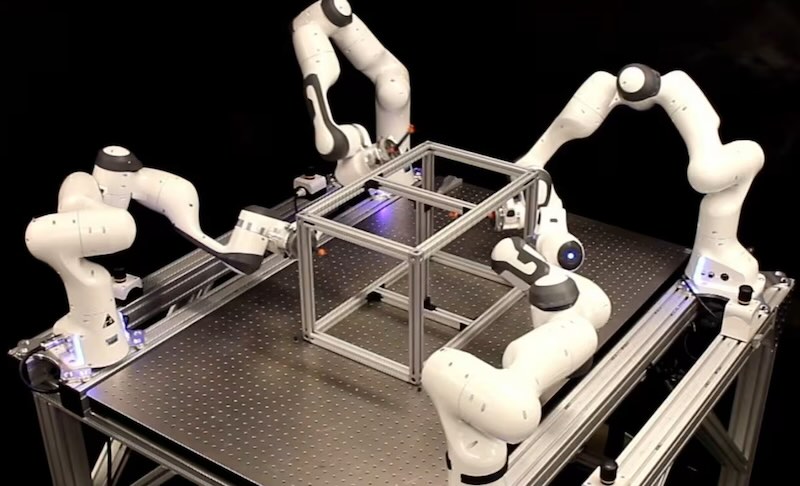Programming industrial robots is a labor-intensive process that often depends on teach pendants, offline tools, and trial-and-error. Coordinating multiple robots in shared spaces adds further complexity, making collisions and inefficiencies likely. With more than 4.3 million industrial robots in use worldwide, the time required for programming remains a major barrier to scaling automation.
A recently published study in Science Robotics proposes a new direction. The paper, “RoboBallet: Planning for Multi-Robot Reaching with Graph Neural Networks and Reinforcement Learning,” details research conducted by Google DeepMind Robotics, Intrinsic, and University College London. The team developed an AI model that uses reinforcement learning and graph neural networks (GNNs) to generate collision-free motion plans for multiple robots in shared workspaces. You can watch the system in action in the video atop this page.
The problem the researchers tackled is not new. Classic motion planning algorithms can produce reliable paths for individual robots. However, scaling those methods to several robots operating in tight quarters becomes computationally difficult. Engineers frequently spend significant time parameterizing algorithms or manually adjusting trajectories to avoid conflicts. The new AI approach aims to automate much of that process.
Intrinsic is a relatively new player in the industrial robotics space. The company spun out of Alphabet’s X “moonshot factory” in 2021 with the goal of making industrial robots easier to use, program, and scale. Since then, it has expanded through both internal R&D and acquisitions. In 2022, Intrinsic acquired the Open Source Robotics Foundation, the organization behind the Robot Operating System (ROS). That move signaled a commitment to supporting the broader robotics community while integrating ROS expertise into Intrinsic’s own development of more intelligent automation tools.

At the core of the method is a GNN trained through reinforcement learning on millions of synthetically generated scenarios. In this framework, robots, tasks, and obstacles are represented as nodes in a graph, while edges define their relationships. The researchers said the model learns to plan trajectories by trial and error, eventually developing generalized strategies that can be applied to new, unseen layouts. Once trained, Intrinsic said the system requires only CAD files and high-level task descriptions to produce motion plans without manual coding, teach pendants, or fine-tuning.
In laboratory evaluations, the model generated motion plans for up to eight robots, often producing near-optimal solutions within seconds. According to Intrinsic, the AI-based approach showed improvements of about 25% in trajectory quality when compared with traditional methods, while also demonstrating strong scalability. For example, when moving from four to eight robots, task execution time decreased by an average of 60%. Intrinsic said this suggests efficiency can increase with system complexity rather than degrade.

The ability to handle “bundles of tasks” without detailed step-by-step instructions makes the system noteworthy. Given a set of objectives, the developers said the model automatically determines the sequence of actions and corresponding collision-free trajectories. Because of the way it encodes relationships between entities in a workcell, it can also adapt to novel scenarios without retraining or human intervention, according to Google DeepMind and Intrinsic.
The RoboBallet team said AI-driven planning could reduce programming time, improve flexibility, and enable faster adaptation to changing product designs or unexpected disruptions. Looking ahead, combining this approach with AI-enabled perception at the edge could allow robots to replan on the fly in response to dynamic changes, further reducing downtime.

